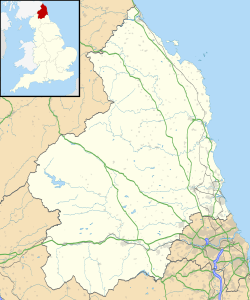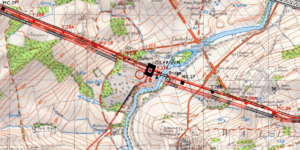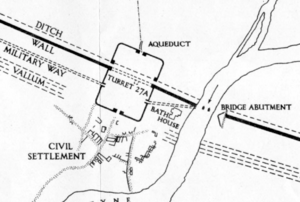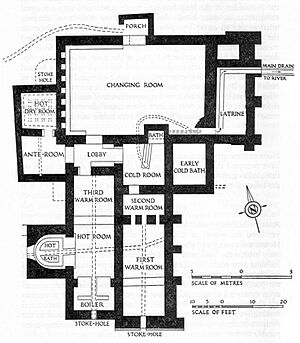Cilurnum facts for kids
Quick facts for kids Cilurnum |
|
|---|---|
 |
|
| Attested by | Notitia Dignitatum |
| Place in the Roman world | |
| Province | Britannia |
| Structure | |
| — Stone structure — | |
| Stationed military units | |
| — Cohorts — | |
| I Delmatarum, I Vangionum | |
| — Alae — | |
| I Augusta ? | |
| Location | |
| Coordinates | 55°01′34″N 2°08′20″W / 55.026°N 2.139°W |
| County | Northumberland |
| Country | England |
| Reference | |
| UK-OSNG reference | NY911701 |
Cilurnum (say "Sil-UR-num") was an ancient Roman fort. It was built on Hadrian's Wall in England. Today, it's known as Chesters Roman Fort. You can find it near the village of Walwick in Northumberland.
This fort is special because it's one of the best-preserved Roman cavalry forts. Cavalry means soldiers who fight on horseback. The site is now looked after by English Heritage. There's also a museum there. It shows things found at the fort and other places along Hadrian's Wall.
Contents
The Roman Fort at Chesters
Hadrian's Wall was started in 122 AD. The forts, like Cilurnum, were built a few years later. Cilurnum was first designed for cavalry. Its walls stuck out north of the main Wall. This allowed soldiers to quickly ride out to the north. Later, it was used by infantry, who were foot soldiers.
Archaeologists learned a lot about Hadrian's Wall here. They found that an early watchtower was built where the fort now stands. This tower and a ditch had to be removed to build the fort. This showed that new cavalry forts were not just for defending the Wall. They also helped launch quick attacks into the lands to the north.
A road connected the fort's southern gate to another Roman road called the Stanegate. Two smaller gates allowed the Roman Military Way to pass through the fort. This was a road for soldiers and supplies. The fort's walls were about fifteen feet high. The gates and towers were even taller, over 9 meters (30 feet) high.
The fort also protected Chesters Bridge. This bridge carried the Military Way across the River North Tyne. You can still see the huge stone supports of this bridge today.
Who Guarded the Fort?
Different groups of Roman soldiers lived at Cilurnum. An early discovery showed that a cavalry unit was here first. It was called ala Augusta ob virtutem appellata. This means "Augusta wing, named for its bravery."
Later, other units were stationed here. These included the Cohors I Delmatarum. These soldiers came from a place called Dalmatia, which is now part of Bosnia-Herzegovina. Another group was the Cohors I Vangionum Milliaria Equitata. They came from Germany.
The Roman Baths
The fort had a bathhouse for the soldiers. It was located on the western bank of the River North Tyne. This was very close to the Roman bridge. Over time, the baths were changed and repaired many times.
These baths are thought to be the most impressive on Hadrian's Wall. They are also one of the best-preserved Roman military bathhouses anywhere.
The Civilian Settlement
Outside the fort's southern gate was a large civilian settlement. This was called a vicus. It grew up along the road leading to the Stanegate. People who were not soldiers lived here. They might have been families of soldiers or people who sold goods and services.
The vicus probably started to be built around the 3rd century. The main street from the fort's south gate curved west. Other smaller streets joined it. Along these streets were buildings, some quite fancy. They had many rooms and corridors, like townhouses.
Discovering the Past
In the early 1800s, a man named Nathaniel Clayton owned the land. He covered the fort's remains with earth to make his park look smooth. But he saved many Roman objects he found.
His son, John Clayton, inherited the land in 1832. John was very interested in history. He uncovered the fort again and dug up the ruins. He also started a small museum to keep the things he found. John Clayton also bought and explored other Roman sites along Hadrian's Wall.
The Museum Today
The museum building was finished in 1903. It's a special old building designed by Richard Norman Shaw. Inside, you can see many of the Roman objects that John Clayton collected.
The collection is now looked after by English Heritage. They have worked to update the museum. This makes it easier for visitors to learn about the Roman past.
Images for kids
See also
 In Spanish: Cilurnum para niños
In Spanish: Cilurnum para niños









